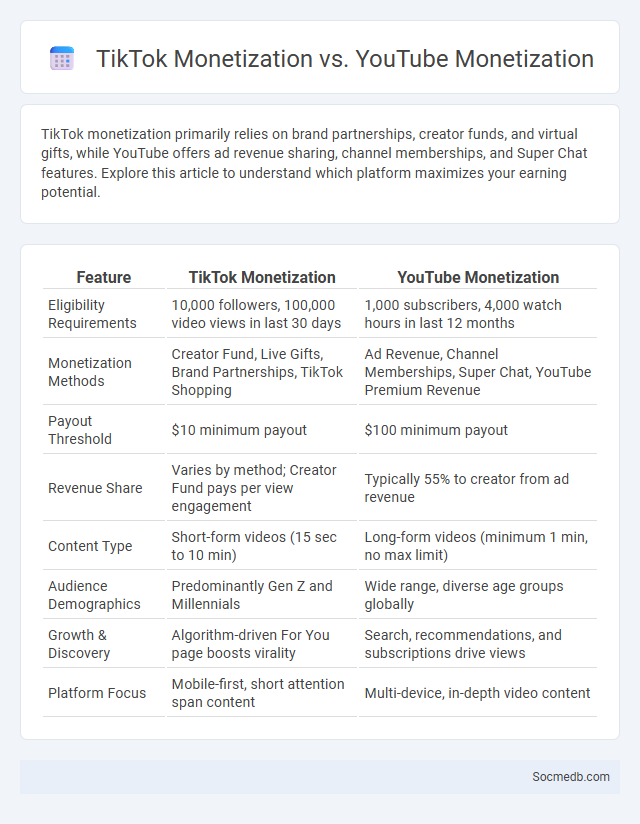
Photo illustration: TikTok Monetization vs YouTube Monetization
TikTok monetization primarily relies on brand partnerships, creator funds, and virtual gifts, while YouTube offers ad revenue sharing, channel memberships, and Super Chat features. Explore this article to understand which platform maximizes your earning potential.
Table of Comparison
| Feature | TikTok Monetization | YouTube Monetization |
|---|---|---|
| Eligibility Requirements | 10,000 followers, 100,000 video views in last 30 days | 1,000 subscribers, 4,000 watch hours in last 12 months |
| Monetization Methods | Creator Fund, Live Gifts, Brand Partnerships, TikTok Shopping | Ad Revenue, Channel Memberships, Super Chat, YouTube Premium Revenue |
| Payout Threshold | $10 minimum payout | $100 minimum payout |
| Revenue Share | Varies by method; Creator Fund pays per view engagement | Typically 55% to creator from ad revenue |
| Content Type | Short-form videos (15 sec to 10 min) | Long-form videos (minimum 1 min, no max limit) |
| Audience Demographics | Predominantly Gen Z and Millennials | Wide range, diverse age groups globally |
| Growth & Discovery | Algorithm-driven For You page boosts virality | Search, recommendations, and subscriptions drive views |
| Platform Focus | Mobile-first, short attention span content | Multi-device, in-depth video content |
Overview: TikTok Monetization vs YouTube Monetization vs Virality
TikTok monetization primarily revolves around creator funds, brand partnerships, and in-app gifts, offering rapid growth potential due to its algorithm-driven virality. YouTube monetization includes ad revenue, channel memberships, and Super Chats, providing more consistent income opportunities but requiring sustained content engagement. You can leverage TikTok's fast-paced exposure to boost early visibility while using YouTube's diverse revenue streams for long-term financial stability.
Monetization Models: How TikTok, YouTube, and Viral Content Differ
TikTok leverages short-form viral videos through creator funds and in-app purchases to monetize content, emphasizing rapid audience growth and engagement. YouTube relies heavily on ad revenue sharing, channel memberships, and Super Chat features, catering to longer content and diverse creator communities. Your choice between platforms should consider these monetization models, aligning with your content style and income goals.
Earning Potential: Comparing Revenue Streams
Social media platforms offer diverse earning potential through various revenue streams such as sponsored content, affiliate marketing, merchandise sales, and ad revenue shares. Influencers can monetize large follower bases by partnering with brands for paid promotions, while creators benefit from platform-specific programs like YouTube AdSense and TikTok Creator Fund. Understanding audience demographics and engagement rates is critical for maximizing income and selecting the most profitable revenue channels across social media networks.
Algorithms and Virality: Key Drivers on Each Platform
Social media algorithms prioritize content based on user engagement, relevance, and timeliness, significantly influencing the visibility and virality of posts across platforms like Facebook, Instagram, and TikTok. TikTok's algorithm, for example, leverages machine learning to personalize the "For You" feed, rapidly amplifying viral videos through user interactions such as likes, shares, and comments. Understanding these algorithms is crucial for maximizing reach and driving organic growth, as virality emerges from a complex interplay of content quality, user behavior, and platform-specific recommendation systems.
Audience Engagement: Building Loyal Followers
Maximizing audience engagement on social media requires consistent interaction through meaningful content and prompt responses to your followers' comments and messages. Creating authentic connections by sharing valuable insights, user-generated content, and personalized experiences encourages loyalty and trust among your community. Your ability to foster a two-way communication channel transforms passive viewers into active, dedicated supporters eager to engage with your brand.
Content Format: Short-Form vs Long-Form Impact
Short-form content thrives on platforms like TikTok and Instagram, capturing attention quickly with bite-sized, engaging videos under 60 seconds, boosting Your brand's visibility and shareability. Long-form content, such as detailed blog posts, podcasts, or YouTube videos, provides depth and authority, fostering stronger audience trust and higher SEO rankings. Balancing both formats maximizes reach and engagement, catering to diverse user preferences and consumption habits.
Brand Partnerships and Sponsorships
Social media platforms offer powerful opportunities for brand partnerships and sponsorships, enabling targeted audience engagement and amplified brand visibility. Leveraging influencers and content creators allows your brand to tap into niche markets and build authentic connections. Strategic collaborations enhance credibility and drive measurable ROI across your marketing campaigns.
Platform Requirements: Eligibility and Monetization Policies
Social media platforms typically require users to meet minimum eligibility criteria such as age restrictions, geographic location, and follower count to qualify for monetization programs. Monetization policies enforce guidelines on content originality, copyright compliance, and advertiser-friendly material to ensure quality and brand safety. Platforms like YouTube, Instagram, and TikTok continuously update these requirements to balance creator earnings with community standards and advertiser preferences.
Analytics and Performance Tracking
Social media analytics tools provide in-depth insights into audience behavior, engagement metrics, and content performance across platforms like Facebook, Twitter, and Instagram. Performance tracking enables marketers to measure key indicators such as click-through rates, conversion rates, and follower growth, optimizing campaigns for higher ROI. Real-time data visualization and trend analysis empower businesses to make data-driven decisions that enhance user engagement and brand reach.
Choosing the Best Platform for Maximum Monetization
Selecting the best social media platform for maximum monetization depends on audience demographics, engagement rates, and content format compatibility. Instagram and TikTok offer high potential for visual and influencer marketing income, while YouTube excels in long-form video monetization through ad revenue and sponsorships. LinkedIn provides strong monetization opportunities for B2B services and professional content creators targeting niche industries.
 socmedb.com
socmedb.com